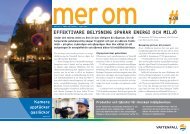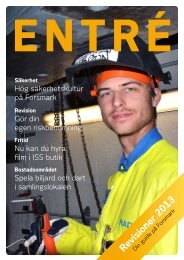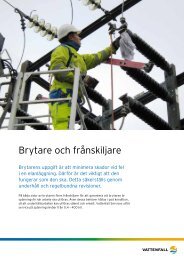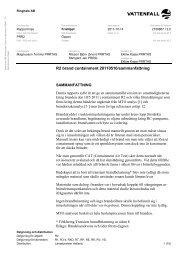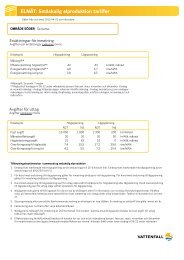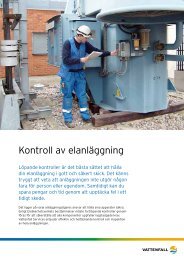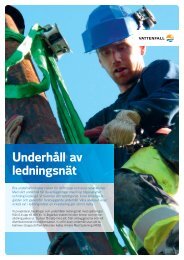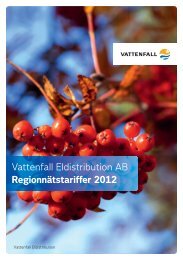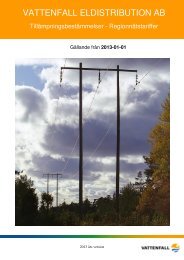This environmental impact assessment for Kriegers flak ... - Vattenfall
This environmental impact assessment for Kriegers flak ... - Vattenfall
This environmental impact assessment for Kriegers flak ... - Vattenfall
Create successful ePaper yourself
Turn your PDF publications into a flip-book with our unique Google optimized e-Paper software.
68 PRESENTATION OF THE AREA<br />
varies between 16 and 25 metres, increasing towards<br />
north east. Along the outskirts of the shallow area, the<br />
depth quickly increases towards 40 metres.<br />
In principle, all Þ ne-grained sediments have already<br />
eroded from the top of <strong>Kriegers</strong> Flak, and the seabed<br />
there<strong>for</strong>e mainly consists of clay moraine, which<br />
probably, according to seismic and sonar research, is<br />
covered by courser sediments such as stones and rocks.<br />
Locally, the clay moraine is covered by thin sand lines<br />
even within the shallow area.<br />
As the water depth increases towards northwest and<br />
gradually towards east/northeast, the seabed is inß uenced<br />
to a lesser extent by currents and movements<br />
of water, why Þ ner coursed sediments can be found.<br />
In the outskirts of the shallow area at a water depth of<br />
around 40 metres, ß uvial sediments can be found with<br />
a powerfulness of between 5 and 10 metres. The ß uvial<br />
sediments are heterogeneous in their composition with<br />
grain sizes varying from mainly silt and clay soils, and<br />
locally with elements of organic material, passing from<br />
clay to mud-like soil. The ß uvial sediments on top of<br />
the clay moraine, are usually covered by a layer of sand<br />
with powerfulness of a couple of metres. The seabed<br />
outside the peripherals generally stretches horizontally,<br />
showing only small variations in depth within the area<br />
studied. Locally, a limited number of cavities can be<br />
noted. In these cavities an increased powerfulness can<br />
be noted on both the ß uvial sediments and covering<br />
sand layer. The sediments may also contain courser<br />
material such as gravel, stone and rock.<br />
As mentioned previously, moraine ridges along the<br />
seabed can be observed in the north-eastern part of<br />
<strong>Kriegers</strong> Flak. The ridges show a height of around 5<br />
metres.<br />
The peripherals of the bank are in the north-eastern<br />
part covered by gravel, stone and rock.<br />
For a more detailed description of the speciÞ c geotechnical<br />
conditions, see Attachment 4.3.<br />
11.2 Hydrography<br />
11.2.1 Current conditions/fl ow of salt water<br />
in the Baltic Sea<br />
<strong>Kriegers</strong> Flak is situated in the south-eastern part of<br />
the Baltic Sea on the western edge of the Arcona basin,<br />
which is the most westerly of a number of cascade<br />
shaped basins in the southern Baltic. The deepest basin<br />
is the Gotland basin at 460 metres.<br />
The <strong>Kriegers</strong> Flak bank is an area with around 20<br />
metres depth surrounded by a seabed with a depth of<br />
35-40 metres. The water depth east of <strong>Kriegers</strong> Flak<br />
in the central parts of the Arcona basin is around 45<br />
metres.<br />
The Baltic is generally completely surrounded by<br />
land masses and the only connection with the North<br />
Sea is via Store and Lille Bælt and the strait of Öresund.<br />
The cross-section of these straits is small in comparison<br />
with the total area of the Baltic, obstructing the<br />
natural ß ow of water. The ß ow is further restricted by<br />
two thresholds at 18 and 8 metres depth respectively<br />
(Darss and Drogden). On its way through the Belts,<br />
salty water mixes partly with out ß owing bracken<br />
water, and has by the time it reaches the threshold<br />
received the salinity and oxygen needed <strong>for</strong> the <strong>for</strong>ma-<br />
Salt and oxygen levels, the sea of Arcona





